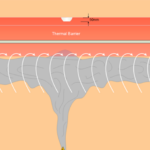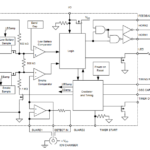The low-cost, reliable, ubiquitous smoke detector is an example of complex physics and optics made real by semiconductors.
This part looks at the two widely used approaches to smoke detection.
Q: How do smoke detectors actually detect smoke?
A: There are two basic and very different approaches, one based on photoelectric principles and the other on ionization principles. Photoelectric smoke alarms (sometimes called optical detectors) are generally more responsive to fires that begin with a long period of smoldering, while ionization smoke alarms are usually more responsive to flaming fires. Since both types of fires occur in homes, there are dual-mode smoke alarms for about 50% more than single-mode units.
Complicating the situation, the U.S. Fire Association notes that in some full-scale fire tests, the difference in the time to alarm between ionization and photoelectric smoke alarms was found to be trivial. In other full-scale fire tests, the difference in response time was significant. Further, the actual location of a smoke alarm within a home may be more important than the type of smoke alarm present, depending on the location of a fire.
Q: How does the photoelectric unit operate?
A: Conceptually, it is very simple. In the most common arrangement (Figure 1), an LED (1) generates a small light beam that passes through a sensing chamber (2). When no particles are present in the chamber, the light from the beam goes directly across the chamber and does not strike the light detector (which is offset from the normal path), thus indicating all clear. When particles are present, some of the light is reflected off particles (3), and when the amount of light registered by the light detector reaches a certain threshold level, the alarm sounds.

In another photoelectric arrangement, the light sensor is placed directly opposite the light source, and light always reaches the sensor. When smoke particles are present, the intensity of the received light decreases; when it decreases by some threshold amount, it signifies an alarm label that smoke is present.
For either design, the dimensions of the sensing chamber are critical. Typically, these chambers are about 10 millimeters long with a diameter of a few millimeters. Some advanced smoke alarms use two LEDs operating at different wavelengths to enhance the ability to detect smoke particles.
Q: How does the ionization approach work?
A: This technique is far less intuitive. It uses a small bit of safely shielded radioactive material that electrically charges, or ionizes, the air molecules between two metal plates (Figure 2). This produces a small electric current flowing from one plate to the other in the air (2). When smoke or other particles enter the chamber, they attract these ions and carry them away, thus reducing the current flow. If the number of particles entering the chamber is enough to reduce that current to below a certain amount (1), the device will register those particles as smoke (3), and the alarm will sound.

Q: Wait, what’s this about radioactive material—and it is in the home?
A: Most ionization detectors use about one microcurie of Americium-241, a man-made radioactive metal solid, under normal conditions. Americium is produced when plutonium absorbs neutrons in nuclear reactors or during nuclear weapons tests. It is an alpha emitter with a half-life of 432.6 years. This alpha-particle radiation is used for two reasons rather than beta (electrons) and gamma (electromagnetic) radiation: alpha particles have more ionizing power and so ionize enough air molecules to create a detectable current; also, they have low penetrative power, meaning they will be safely stopped by the plastic of the smoke detector or even the air.
Most of the radiation is blocked inside the device, and the radiation levels in the device are much lower than the natural background radiation to which we are exposed every day. Still, some municipalities have special regulations on the disposal of ionizing smoke alarms (often unknown or ignored), while some ban use of ionizing alarms.
Q: How reliable and consistent are smoke alarms?
A: They are quite good, but for both designs, the setting of the good/bad threshold is a tradeoff. They can be made sensitive enough to detect almost any level of smoke, but if they did, they would detect the smoke you don’t want them to detect (such as from cooked food) and even things such as ordinary dust. Less-sensitive detectors would have fewer such “nuisance” alarms, but in an actual fire, they may not go off in time to save lives or property or give off a signal at all.
Some newer smoke alarms embed sophisticated algorithms in firmware that assess rate of rise and other aspects of the sensor’s change to reduce nuisance alarms. This is considered a major advance since users who have repeated nuisance alarms often solve the “problem” by disabling their units. The next generation of smoke detectors aims to cut down on the number of nuisance alarms while also signaling real fires more quickly.
Related EE World content
Smoke detector reference design and algorithm is UL217-tested and verified
SmokeBot – A Robot Serving Rescue Units
AI/ML-based sensor fusion technology platform targets home-security alarm system
Ultra-low-current detect switches optimized for battery-powered devices
Wireless comm ICs cover UHF, ISM bands for smart meter, gas/fire alarm, security system apps
Free-space optical links, Part 1: Principles
Free-space optical links, Part 2: Technical issues
Free-space optical links, Part 3: Standard units
Additional References
General Resources
- National Fire Protection Association “Smoke Alarms in US Home Fires”
- The Zebra, “House Fire Statistics in 2022”
- NIST, “How Do Smoke Detectors Work?
- S. Fire Administration, “USFA position on home smoke alarms”
- National Fire Protection Association, “Ionization vs photoelectric”
- Wikipedia, “Smoke detector”
- Statistica, “Total number of reported home structure fires in the United States from 1977 to 2020”
- IFSEC Global, “Smoke Detectors Explained”
- IFSEC Global, “The science behind optical beam detection in large, open spaces”
- IFSEC Global, “FFE launches auto-aligning smoke beam detector”
Integrated Circuits – Vendor web sites
- Analog Devices, “Smoke Detection”
- Allegro Microsystems, “Smoke Detector Interface ICs”
- Microchip Technology, “Smoke Detector, CO Detector and Horn Driver ICs”
- NXP/Freescale, “MC145010 Photoelectric Smoke Detector IC with I/O”
- Renesas, “RAA239101 Photoelectric Smoke Detector AFE IC”
- Texas Instruments, “Smoke & heat detector Products and reference designs”



